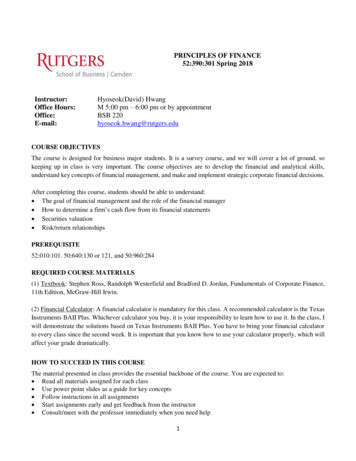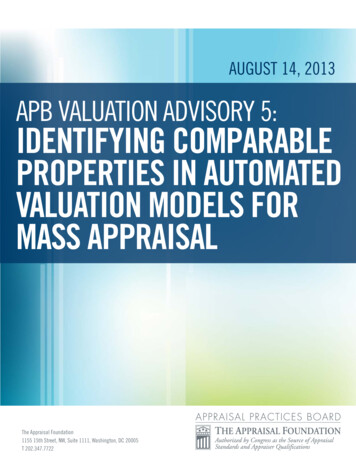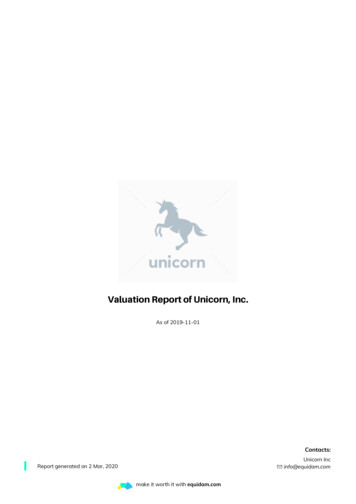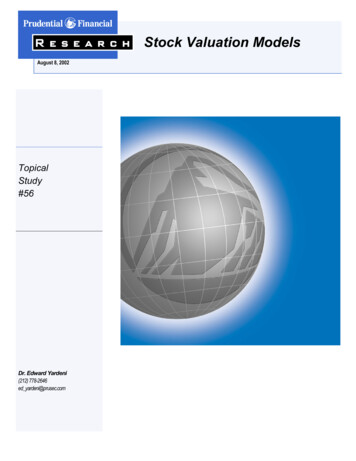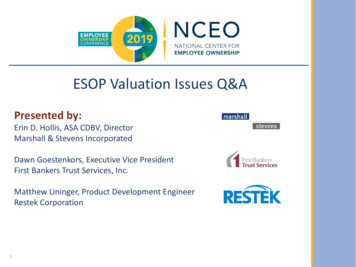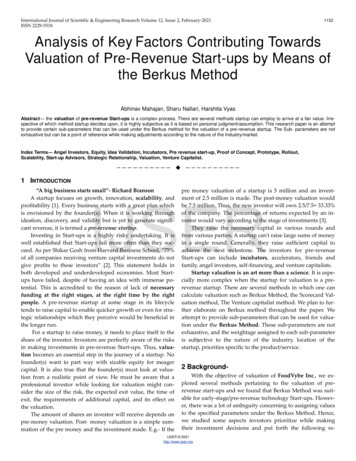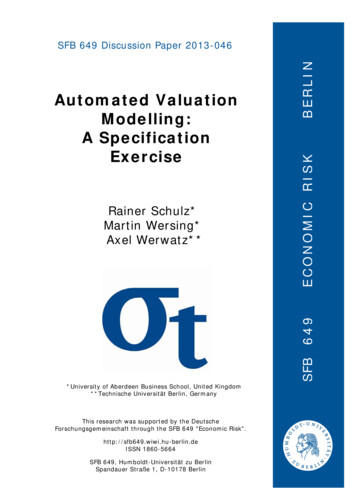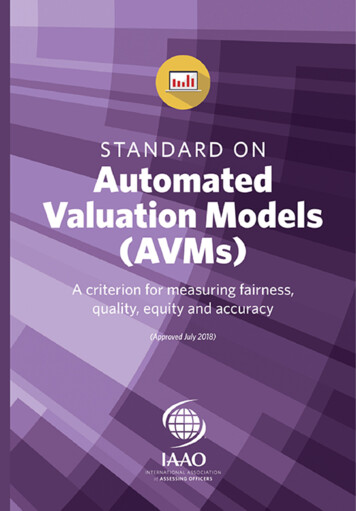
Transcription
STANDARD ON AUTOMATEDVALUATION MODELS (AVMS)
STANDARD ONAUTOMATEDVALUATION MODELS(AVMS)Revised Approved, July 2018International Association of Assessing OfficersIAAO assessment standards represent a consensus in the assessing profession and have beenadopted by the Board of Directors of the International Association of Assessing Officers (IAAO).The objective of the IAAO standards is to provide a systematic means for assessing officers toimprove and standardize the operation of their offices. IAAO standards are advisory in natureand the use of, or compliance with, such standards is voluntary. If any portion of these standardsis found to be in conflict with national, state, or provincial laws, such laws shall govern. Ethicaland/or professional requirements within the jurisdiction[1] may also take precedence overtechnical standards.[1] For example, USPAP, CUSPAP, IVS, EVS.
About IAAOThe International Association of Assessing Officers, formerly the National Association ofAssessing Officers, was founded for the purpose of establishing standards for assessmentpersonnel. IAAO is a professional membership organization of government assessmentofficials and others interested in the administration of the property tax. Over the years IAAOmembers have developed assessment practice and administration standards and many of thesestandards have been adopted by state and international oversight agencies, and some have beenincorporated into legislation.IAAO continues at the forefront of assessment in North America and has been expanding itsreach to the global community for the last five decades. Because standards form the rules bywhich North American assessors perform their duties, they may not be directly applicable to anoverseas audience. The standards have been updated to also present the broad principles uponwhich the rules are based. IAAO believes those principles may be adapted to many differingstatutory and regulatory scenarios worldwide.AcknowledgmentsThe second edition of the AVM Standard (2018) was developed and written through thededicated efforts of the Technical Standards Committee comprised of Alan S. Dornfest,AAS, Chair Bill Marchand, Doug Warr, August Dettbarn, Wayne Forde, Joshua Myers, andCarol Neihardt. Additionally Patrick M. O’Connor served as a special knowledge expert. Thecompleted document was reviewed and edited by the AVM Standard Review and Edit SpecialTask Force comprising of August J. Dettbarn, Chair; Peader Thomas Davis; Leandro Escobar; IngiFinnsson; Randy J. Ripperger, CAE; and Larry J. Clark, CAE.Revision notesThis standard replaces the 2003 Standard on Automated Valuation Models (AVMs) and is acomplete revision.Published byInternational Association of Assessing Officers314 W 10th StKansas City, Missouri 64105-1616816-701-8100Fax: 816-701-8149www.iaao.orgLibrary of Congress Catalog Card Number: ISBN 978-0-88329-245-7Copyright 2018 by the International Association of Assessing OfficersAll rights reserved.No part of this publication may be reproduced in any form, in an electronic retrieval system or otherwise, without the priorwritten permission of the publisher. IAAO grants permission for copies to be made for educational use as long as (1) copiesare distributed at or below cost, (2) IAAO is identified as the publisher, and (3) proper notice of the copyright is affixed.Produced in the United States of America.
STANDARD ON AUTOMATED VALUATION MODELS (AVMS) —2018CONTENTS1. Scope . 1Principles. 12. Principles. 23. Introduction. 4Principles. 43.1 Definition of automated valuation model (AVM) . 43.2 Examples of specific AVM procedures. 43.2.1 Preliminary Data AVM [AVM Assisting Appraisers]. 53.2.2 Interactive Valuation Application AVM [Appraiser-Assisted]. 53.2.3 Repetitive AVM [Continuous Application AVM] . 53.2.4 Blended or Cascading AVM. 53.2.5 Research AVM. 53.3 Purpose of an AVM. 63.4 Development and Application of AVMs. 63.4.1 Scope of Work . 63.4.2 Identification and Acquisition of Property Data. 73.4.3 Exploratory Data Analysis . 73.4.4 Stratification. 73.4.5 Data Representativeness. 83.4.6 Model Specification. 83.4.7 Model Calibration. 83.4.8 Quality Assurance. 83.4.9 Model Application and Value Review . 84. Data quality. 9Principles. 94.1 Data Availability. 94.2 Data Verification. 94.3 Qualitative and Quantitative data. 94.4 Property Identification and Location. 104.5 Data Quality Assurance . 105. Specification and Calibration of AVM Models . 11Principles. 115.1 Model Specification . 115.2 Calibration Techniques . 11i
STANDARD ON AUTOMATED VALUATION MODELS (AVMS) —20185.3 Time Series Analysis. 125.4 Independent Variable Selection for Models. 125.5 Location . 126. Market Analysis and Intended use. 13Principles. 136.1 Identify the Property Class/Type to be Valued. 136.2 Identify Intended Use. 136.3 Identify Limited Data Response. 146.4 Identify the Valuation Approach(es) to be Used . 146.5 Identify Property Characteristics that Have the Greatest Influence on Value.146.6 Identify Geolocational and Economic Influences . 156.7 Cautions. 157. Quality Assurance. 16Principles. 167.1 Model Representativeness . 167.2 Model Diagnostics. 167.3 Ratio Studies . 177.3.1 Measures of Central Tendency. 177.3.2 Measures of Variability. 177.3.2.1 Coefficient of Dispersion (COD). 177.3.2.2 Coefficient of Variation (COV). 177.3.3 Measures of Reliability. 177.3.4 Price Related Vertical Inequities. 187.3.5 Importance of Sample Size. 187.3.6 Outliers. 197.4 Holdout Samples. 197.5 Frequency of Updates. 197.6 Reconciliation of Values. 198. Documentation and Reports. 20Principles. 20References . 21Suggested Reading. 22ii
STANDARD ON AUTOMATED VALUATION MODELS (AVMS) —2018Appendix A. Model Specification . 25A.1 Cost Approach. 25A.2 Sales Comparison Approach . 26A.2.1. Comparable Sales Model. 26A.2.2 Direct Market Model. 26A.2.2.1 Additive models. 26A.2.2.2 Multiplicative models. 27A.2.2.3 Hybrid (Nonlinear) models. 27A.3 Income Approach. 28Appendix B. Calibration Techniques. 29B.1 Calibration Using Statistically Based Methods. 29B.1.1 MRA Assumptions. 29B.1.2 Diagnostic Measures of Goodness-of-Fit. 29B.1.3 MRA Strengths. 29B.1.4 MRA Weaknesses. 30B.2 Artificial Neural Networks. 30B.2.1 Strengths of Neural Networks. 30B.2.2 Weaknesses of Neural Networks. 30B.3 Calibration Summary. 30Appendix C. Statistical Methods for Developing Location Adjustments. 31Appendix D. Time Series Analysis. 32Appendix E. Modeling For AVMs . 33E.1 Market Sale Based Models. 33E.1.1 Comparable Sales Models. 33E.1.2 Direct Market Models. 33E.2 Income Models. 34E.2.1 Modeling Gross Income. 34E.2.2 Vacancy and Collection Losses from Potential Gross Income (PGI).34E.2.3 Modeling Expenses. 34E.2.4 Direct Capitalization. 34E.2.5 Gross Income Multiplier (GIM). 34E.2.6 Property Taxes. 34E.3 Cost Approach Based Models. 35E.3.1 Cost Models. 35E.4 Location Valuation Adjustment. 35E.5 Development of the Land Model(s). 35iii
STANDARD ON AUTOMATED VALUATION MODELS (AVMS) —2018Appendix F: Value Justification. 36Appendix G: Statistical Tables. 37Appendix H: Uses of AVM Reports. 40H.1 Real Estate Lenders. 40H.2 Real Estate Professionals. 40H.3 Government. 41H.4 General Public. 41H.5 Ad Valorem Tax. 41Appendix I: Use of AVM Reports as A Complete Single Property Appraisal Report.42I.1 Credentialing of AVM Developers and End Users . 42I.2 Reporting Format for Finiancial and Ad Valorem Uses. 42iv
STANDARD ON AUTOMATED VALUATION MODELS (AVMS) —2018STANDARD ON AUTOMATEDVALUATION MODELS (AVMS)1. SCOPEThe standard provides principles, guidance, and best practices for developing and using AVMs forthe valuation of real property. The standard is organized with each major section beginning withthe main principles covered in that section, followed by a description of all principles. Greater detailis found in appendices. Following are the key principles within this section.Principles Transparency Public trust — providing confidence for thestakeholdersSpecify model Broad applicability Based on statistically sufficient information Certification and quality assuranceThis standard provides guidance for public and privatesector property valuation that depends on AutomatedValuation Model (AVM) systems. AVMs can be used whensufficient economic data exists to permit developmentof representative and valid statistical samples. Modelsthat adhere to the best practices for data verification,data analysis, market analysis, and ongoing qualitycontrol present the most reliable value estimates.The general format of development and use of an AVMdescribed in this standard is shown in Figure 1.Calibrate the modelTest the modelAdjust modelspecificationsRecalibrate the modelTest the modelRepeat process untilmodel quality assurancetests are metFigure 11
STANDARD ON AUTOMATED VALUATION MODELS (AVMS) —20182. PRINCIPLES TRANSPARENCY Public trust — providing CONFIDENCE for the stakeholders Broad APPLICABILITY Based on statistically SUFFICIENT information Certification and QUALITY ASSURANCE Involvement of a QUALIFIED market analyst is highly advisable AVM products lead to the development of additional valuation services (APPLICABILITY) AVM value estimates developed and operated under this standardmay be considered an appraisal (APPLICABILITY) Quality assurance for all phases of AVM development andoperations is advised (QUALITY ASSURANCE) AVM development is a multiple step iterative process (STATISTICAL PRINCIPLES) Data availability will influence the model development (SUFFICIENCY) Data should be STATISTICALLY verified Quantitative data is more objective (STATISTICAL PRINCIPLES) Qualitative data is more subjective (STATISTICAL PRINCIPLES) Model specification should follow recognized APPRAISAL PRINCIPLES Adjustments should be considered for location andmarket trends (APPRAISAL PRINCIPLES) Market analysts should review the data to insure representativeness Variable selection requires in-depth knowledge of appraisaland advanced statistical analysis (QUALIFICATION) Account for the effects of location (APPRAISAL PRINCIPLES) The market analyst should statistically review the reasonablenessof the data (STATISTICAL PRINCIPLES) Multiple years of market data may be used (STATISTICAL PRINCIPLES) Independent appraisals may be used as proxy sales when dealingwith limited sales (APPRAISAL PRINCIPLES) Use of standardized geographical coordinate systems aids in thecapture of location influences (APPRAISAL PRINCIPLES) Use of qualitative data requires specialized knowledge (QUALIFICATION) Data must be sufficient and representative (SUFFICIENCY) Statistical methods should form the basis of quality assurance (QUALITY ASSURANCE) Continuous run models require periodic statistical testing Sales and economic data should be open market transactions (APPRAISAL PRINCIPLES) Both point estimates and reliability measures should be used in evaluatingcentral tendency and variability of results (STATISTICAL PRINCIPLES) Samples should be evaluated for outlier influence (STATISTICAL PRINCIPLES)2
STANDARD ON AUTOMATED VALUATION MODELS (AVMS) —2018 Holdout samples or cross validation methods should be used tovalidate the model’s performance (STATISTICAL PRINCIPLES) Documentation needs to be available to explain andsupport the model results (TRANSPARENCY) The type of AVM dictates the nature of documentation (PROPORTIONALITY) Report design should clearly indicate the value resultsoutput by the model (TRANSPARENCY)3
STANDARD ON AUTOMATED VALUATION MODELS (AVMS) —20183. INTRODUCTIONPrinciples Involvement of a qualified market analyst is highly advisable AVM products lead to the development of additional valuation services AVM value estimates developed and operated under this standard may be considered anappraisal Quality assurance for all phases of AVM development and operations is advised AVM development is a multiple step iterative process3.1 DEFINITION OF AUTOMATED VALUATION MODEL (AVM)A mathematically based computer software program that market analysts use to produce anestimate of market value based on market analysis of location, market conditions, and real estatecharacteristics from information that was previously and separately collected. The distinguishingfeature of an AVM is that it is a market appraisal produced through mathematical modeling.Credibility of an AVM is dependent on the data used and the skills of the modeler producingthe AVM. AVMs should be developed by appropriately qualified market analysts, e.g. appraisers/valuers, who use statistically-based applications to analyze data and select the best simulation ofmarket activity for the analysis of location, market conditions, and property characteristics frompreviously collected data. AVMs are designed to generate value estimates for properties at specifiedpoints in time (retrospective or prospective dates as required by client).3.2 EXAMPLES OF SPECIFIC AVM PROCEDURES AVM Assisting Appraisers [Preliminary Data AVM] Appraiser-Assisted AVM [Interactive Valuation Application AVM] Repetitive AVM [Continuous Application AVM] Blended or Cascading AVM Research AVMAVMs use: sales comparison approach; cost approach; income approach4
STANDARD ON AUTOMATED VALUATION MODELS (AVMS) —20183.2.1 Preliminary Data AVM [AVM Assisting Appraisers]After analysts develop the AVM application, appraisers use these AVMs in their professional assignments. Some common uses are: Location adjustments Time trend adjustments Contributory value of building featuresThe AVM sorts substantial amounts of electronic data and provides selected raw or basic datafor interpretation by the appraiser. Appraisers may use the AVM applications to support theiropinions of value. These appraisers may provide explanations and use their own data, which theyhave collected or properly verified.3.2.2 Interactive Valuation Application AVM [Appraiser-Assisted]This is a mathematical model application, or a set of applications, that is/are developed, calibratedand checked by analysts with valuation knowledge. In these model applications, an appraiserreviews results and then uses professional judgement to consider modifying model results. Anymodification should be subject to quality assurance testing.3.2.3 Repetitive AVM [Continuous Application AVM]In this type of AVM, mathematical applications are prepared by an analyst after market analysis.The AVM application is intended to be used repeatedly to project values for future dates, withoutrecalibration but through the addition of new sale prices and economic information. This processmay reduce the reliability of the AVM application. If analysts are unsure of the valuation application’s ability to generate prospective valuations, the AVM application should be recalibrated.3.2.4 Blended or Cascading AVMThe cascade process allows application of two or more AVMs using a single interface. The cascadeprocess allows the user to leverage the strengths of multiple AVMs by fitting for location, propertytype, and projected price range. The weakness of the cascading system is that the user can manipulate the final estimates of value.3.2.5 Research AVMResearch AVMs are general valuation tools which resemble production AVMs in design, but havelimited functionality. Research AVMs are used for initial testing of concepts and are only usedfor testing purposes. They are used in academic research to measure trends in real estate values.They are also used in public administration such as projecting values for planning or underwritingpurposes.5
STANDARD ON AUTOMATED VALUATION MODELS (AVMS) —20183.3 PURPOSE OF AN AVMThe purpose of an AVM is to efficiently provide an accurate, uniform, equitable estimate of fairmarket value. Fair market value defined; allowable variance; factors to be considered in determiningfair market value; generally accepted appraisal procedures to be utilized. “Fair market value” meansthe amount in terms of money that a well-informed buyer is justified in paying and a well-informedseller is justified in accepting for property in an open and competitive market, assuming that theparties are acting without undue compulsion. All AVM values should be reviewed for reliability.AVM values generated in compliance with regulations of the governing bodies are consideredappraisals. Models that adhere to the best practices for data verification, data analysis, marketanalysis, and ongoing quality assurance present the most reliable value estimates.3.4 DEVELOPMENT AND APPLICATION OF AVMSAVMs are developed using appraisal principles and techniques. Data are acquired and analyzed todevelop a market valuation model that can be applied to equivalent properties (sold or unsold) inthe same market area. Two major components of valuation modeling are specification and calibration. The model specification process identifies property characteristics (variables) that impactand demand and develops the proposed model structure. Model calibration is the process ofderiving coefficients for the variables previously specified in addition variables are created throughtransformations to avoid collinearity problems. Specification and calibration techniques vary withthe purpose of the AVM, type of property, available data, and the experience and knowledge of themarket analyst. The basic steps in the development of an AVM are: Creation of a scope of work Identification and acquisition of property data Exploratory data analysis Stratification Determination of data representativeness Model specification Model calibration Quality assurance Model application and value reviewModel specification, calibration, and quality assurance are iterative processes that are repeateduntil statistical diagnostics are satisfactory.3.4.1 Scope of WorkThe scope of work defines the type of property and geographic area in which the AVM will beapplied, and the steps required to develop and implement the AVM. The scope of work should stateall assumptions, special limiting conditions, and hypothetical conditions.A key assumption in many AVM appli
sector property valuation that depends on Automated Valuation Model (AVM) systems. AVMs can be used when sufficient economic data exists to permit development of representative and valid statistical samples. Models that adhere to the best practices for data verification, data analysis, market analysis, and ongoing quality
